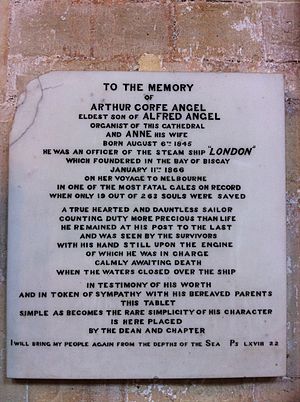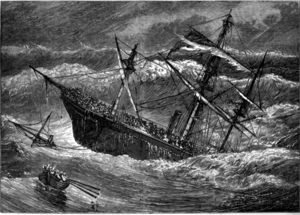SS London (1864) facts for kids

London under way
|
|
Quick facts for kids History |
|
|---|---|
| Name | London |
| Owner | Money Wigram and Sons |
| Operator | Money Wigram and Sons |
| Builder | Money Wigram and Sons, Blackwall Yard |
| Launched | 20 July 1864 |
| Out of service | 11 January 1866 |
| Identification | |
| Fate | Sank, 11 January 1866 |
| General characteristics | |
| Tonnage | 1,429 |
| Length | 276.6 ft (84.3 m) |
| Beam | 35.9 ft (10.9 m) |
| Draught | 24.1 ft (7.3 m) |
| Installed power | 200 nhp |
| Propulsion | Compound engines by Humphrys and Tennant of Deptford |
| Speed | 9 knots (17 km/h; 10 mph) |
| Capacity | 317 passengers |
| Crew | 90 |
The SS London was a British steamship that sank in the Bay of Biscay on January 11, 1866. The ship was sailing from Gravesend, England, to Melbourne, Australia. On January 10, it started taking on water. There were 239 people on board.
The ship was carrying too much cargo, which made it unsafe. Only 19 people managed to escape in a lifeboat. This disaster caused 220 deaths.
Contents
Building and Early Voyages of the London
The London was built in Blackwall Yard by a company called Money Wigram and Sons. It was launched into the River Thames on July 20, 1864. The ship weighed 1,429 tons. It was officially registered in London.
The London began its sea trials on September 23, 1864. Its first trip to Melbourne started on October 23, 1864. It stopped in Portsmouth and Plymouth along the way. During this trip, a small boat with crew members was lost while looking for a man who fell overboard. Luckily, another ship rescued them. The London reached Cape Town on December 5, 1864, and arrived in Melbourne on January 2, 1865.
On February 4, 1865, the ship left Melbourne to return to London. It carried 260 passengers and about 2,799 kilograms of gold. It arrived back in Gravesend on April 26, 1865.
The London started its second trip to Melbourne in late May 1865. It arrived there on August 4. On September 9, 1865, it began the return journey with 160 passengers and about 2,657 kilograms of gold. The ship reached London in November of that year.
The Final Journey and Sinking of the London
The London's last voyage began on December 13, 1865. It left Gravesend, heading for Melbourne, Australia. Captain Martin, an experienced sailor, was in charge. A famous story says that as the ship sailed down the Thames, a sailor saw it and said, "It'll be her last voyage…she is too low down in the water, she'll never rise to a stiff sea." Sadly, this prediction came true.
The ship was supposed to pick up more passengers in Plymouth. However, it ran into bad weather. Captain Martin decided to find shelter near Portsmouth. The London eventually made it to Plymouth. The journey to Australia started again on January 6, 1866. There were 263 people on board, including six who had hidden on the ship.
Three days later, while crossing the Bay of Biscay, the ship faced huge waves. The cargo inside the ship shifted, and its drainage holes (scuppers) became blocked. This made the ship sit lower in the water, and giant waves crashed over it. Water poured into the cargo areas, putting out the engine fires. Captain Martin decided to turn the ship around and head back to Plymouth. This meant sailing directly into the storm.
On January 10, after days of being hit by waves, one of the lifeboats was washed away. Later that day, another wave broke parts of the ship's mast and rigging. On January 11, a massive wave crashed onto the deck. It smashed the engine room hatch, letting water flood in and completely stop the engines.
By January 12, the ship was almost level with the sea. The crew decided to abandon the ship. Most lifeboats were immediately swamped by waves as they were launched. Only one lifeboat stayed afloat. Nineteen people managed to get into this boat; only three of them were passengers. When the lifeboat was about 100 yards away, the London began to sink, stern first.
As the ship went down, everyone on deck was pushed forward by the rush of air from below. The front of the ship rose high, showing its bottom, and then it was "swallowed up…in a whirlpool of confounding waters." The London took 244 people with it. It was said that the last sound heard from the sinking ship was the hymn "Rock of Ages". The nineteen survivors in the lifeboat were rescued the next day by another ship called the Marianople. They were taken to Falmouth.
The Scottish poet William McGonagall wrote a poem about this disaster called The Wreck of the Steamer 'London' while on her way to Australia.
Why Did the London Sink?
An investigation by the Board of Trade found three main reasons for the sinking of the London:
- Turning Back into the Storm: Captain Martin decided to turn the ship around and go back to Plymouth. It is believed the ship had already passed the worst of the storm. By turning back, the London re-entered the dangerous weather.
- Overloaded with Cargo: The ship was carrying too much weight. It had an extra 345 tons of railway iron.
- Blocked Drainage Holes: There were 50 tons of coal stored on the deck. When waves washed over the ship, this coal blocked the scupper holes. These holes were meant to drain seawater from the deck, but with them blocked, water stayed on deck, making the ship even heavier and lower in the water.
Messages in Bottles Found from the London
After the sinking, some bottles were found on the French coast of the Bay of Biscay. These bottles contained messages from people who were on the London.
One message was from D.W. Lemmon, who was presumed to have drowned. He wrote: "The ship is sinking, no hope of being saved." Another message was from Mr. H.F.D. Denis. He wrote: "Goodbye, father, brothers and sisters, and my dear Edith. Steamer London, Bay of Biscay. Ship too heavily laden for its size, and too crank. Windows stove in. Water coming in everywhere. God bless my poor orphans. Storm not too violent for a ship in good condition." These messages were heartbreaking farewells to their families.
Lost Diamonds on the London
In a book he wrote, Frederick Chapman shared a sad story. His mother, two brothers, and a sister died in the London shipwreck. He wrote that in December 1865, his mother showed him a huge collection of diamonds. These diamonds had been passed down in their family. Less than a month later, on January 11, 1866, the sinking of the SS London carried this valuable collection to the bottom of the Bay of Biscay.
The London's Impact on Shipping Safety
The tragic loss of the London brought a lot of attention to dangerous ships. These ships were sometimes called "coffin ships" because they were overloaded by owners who didn't care about safety. The public outcry from this disaster played a big part in Samuel Plimsoll's efforts to make shipping safer.
The disaster helped push the government to create the famous Plimsoll line. This line is painted on the side of ships to show how much cargo they can safely carry. It took many years, but the London disaster helped save many lives in the future.
Notable People Lost on the London

Many people from different walks of life were lost when the London sank. Here are some of them:
- John Debenham, son of William Debenham, who founded the Debenham and Freebody's department stores.
- Gustavus Vaughan Brooke, a famous Irish stage actor.
- Thomas Maxwell Tennant, from Bowershall Engine Works, Leith.
- James and Elizabeth (née Fly) Bevan, who were the parents of James Bevan, the first captain of the Wales rugby union team.
- John Woolley, who was the first principal of the University of Sydney, Australia.
- Reverend Daniel James Draper, a Methodist missionary, and his wife, Elizabeth Shelley Draper.
- Catherine Brewer Chapman and her three children: Henry Brewer Chapman, Catherine Ann Chapman, and Walter George Constantine Chapman. They were the wife and children of Henry Samuel Chapman, a judge in New Zealand and a key figure in introducing the secret ballot in Victoria.



